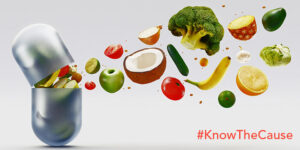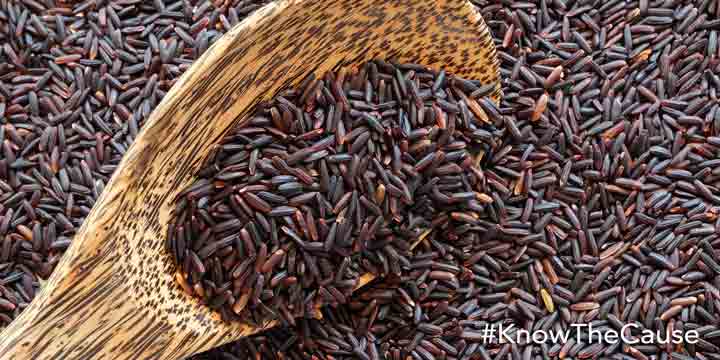

Rice is forbidden on the Kaufmann 1 portion of the Kaufmann Diet.
However, there’s a type of rice called “Forbidden Rice” which is possibly going to make it’s way to the updated version of Kaufmann 1 or Kaufmann 2 of the Kaufmann Diet.
There are at least 3 reasons why this black rice should be part of the Kaufmann Lifestyle:
1). Its Nutrition Is Similar To Dark Berries
Black rice is loaded – and I mean loaded – with anthocyanins. When you see the dark color of blueberries or blackberries, it’s due to anthocyanins. This is why I jokingly say black rice is “a berry disguised as a grain”.
There are a number of reasons why anthocyanins need to be part of your diet. They’re antifungal, they’re anti-inflammatory, they seem to support heart and artery health, and they support optimal insulin function.
The current research suggests that a serving of black rice has more health-promoting anthocyanins than blueberries, which means it should be considered as a valid part of the Kaufmann Diet.
2. Protein
A quarter-cup of dry black rice contains about 5 grams of protein – very respectable for a non-animal protein. This makes it great for vegans, or for anyone needing more protein in their diet.
3. Fiber
In fairness, I’ve never thought moderate servings of rice were powerhouses of fiber. 2-3 grams per serving isn’t that much, but it’s what to expect from virtually all rice varieties. Black rice matches this, and every little bit adds up.
4. Liver optimization
The anthocyanins and other components of black rice all seem to be so liver-friendly that some researchers have even suggested that black rice should be considered a dietary “liver detox”. This is because of some very interesting animal studies showing that liver function improved in animals eating a black rice diet.
The dark pigments certainly do have their place in a liver-friendly diet, but it’s too soon to say whether the extraordinary benefits in animals’ liver health will also be observed in human beings. (But I’m not waiting to find out!)
5. Iron
If you don’t eat red meat or you’re still not too fond of leafy greens, black rice may be a good way for you to get more iron. Like fiber, some people make a fuss over a few extra milligrams of iron in a plant food. It seems a little scant to me, providing 4% of your daily iron needs in a (dry) quarter cup. But if I didn’t eat red meat very often, or kale shakes weren’t my thing, I’d definitely want every bit of iron from plant foods that I could get, and black rice has more than other rice varieties.
6. Gluten-Free
About 1% of the population is gluten-intolerant, but 40% of Americans say they eat gluten-free. I’m not sure why you’d avoid gluten if you didn’t have to; but if you fall into the gluten-free camp, here’s another nutritional powerhouse to add to your diet. (Just know that gluten-free and Kaufmann’s Diet are NOT one and the same!)
Cooking Black Rice
I make extra black rice ahead of time because it’s a long-cook variety.
I tend to let it soak overnight to reduce an already long cook time. Soak rice in pure water and cover it overnight. Then drain and rinse. Finally, use twice the amount of water as rice, (I’ll cook 1 cup of rice at a time, so I boil it in 2 cups of water).
Heat to a boil, then let it simmer for 30 minutes if you soaked it overnight, or an hour or more if you weren’t able to soak it.
Coconut Black Rice “Milk”
My favorite sweet treat with black rice is to simply add some thick Thai coconut milk to your rice, along with stevia to taste. (Sorry – no specific recipe proportions for this one. I usually eyeball it until it looks right, and add enough stevia to sweeten it just a little bit.)
Stir it up and get ready for an incredible sweet treat.
Of course, you can also just add butter and salt for a rich, nutty taste experience as a nutrient-dense side dish to most any meal.
If you haven’t tried Forbidden Rice, forbid yourself no longer. This is a winner.
Doug Kaufmann has written many books that cover a full range or health issues. Find out which of his books best suits you by clicking the button below.
Doug Kaufmann developed his diet after years studying the clinical effects of pathogenic fungi on the body. Fungi and yeasts can become parasitic organisms on and inside our body, causing health problems that can be difficult to diagnose. Learn more about the Kaufmann Diet, change your life and know the cause.
We encourage all visitors to this site to take some time and study these technical articles prior to initiating lifestyle changes, including dietary changes and to do so with their physician’s awareness and approval. The articles posted in this link are scientific and with few exceptions are taken from medical journals familiar to healthcare workers.
Looking for help assembling antifungal Kaufmann Diet approved recipes for breakfast, lunch or dinner? We have several videos, books and recipe write ups here on Know the Cause that will help your health journey. The recipes in this section are so good, you’ll feel like you’re indulging. No sacrifice needed! Enjoy.
© 2024 Mediatriton Inc. All Rights Reserved • Website by Skynet Solutions